EMPEROR RENZONG (Zhao
Zhen), TYCHO, KEPLER, A STAR AND PLAGUE
宋仁宗
|
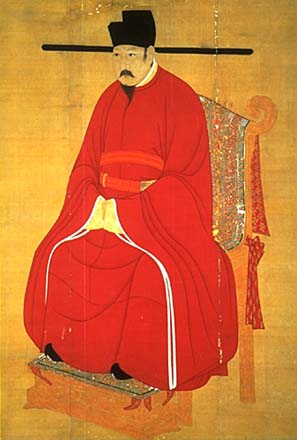 |
| Renzong. PD image.
Source: Wikimedia. |
Emperor Renzong (宋仁宗) lived May 30, 1010 – April 30, 1063 and ruled
the Northern Song empire for over 40 years, including the era of SN 1054. He reigned at the height of the Song empire
and was blamed
for its later disintegration by following a policy of pacifism in foreign
affairs, while allowing the
army to lose its strength and encouraging bureaucracy to grow, but what is not so widely mentioned is his reformation of Chinese
medicine and the reasons behind it.
In the past omens in the sky such as
comets, new stars, eclipses, conjunctions or massing of the planets were
thought not only to be indicators of the fates of people and nations but to
bring disease from the sky. Different nations saw these signs different ways,
sometimes they foretold great things but more often they were harbingers of
doom. In the Song dynasty as
in the time of Tycho the celestial bodies were blamed for all manner of
misfortune, war, famines and pestilence. Below are
examples of illustrations of comets showing them as portenders of doom:
|
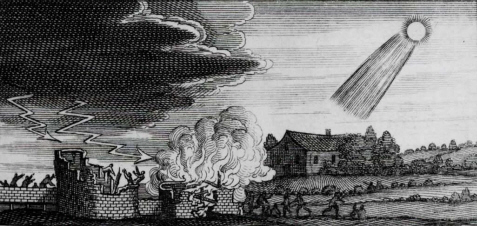 |
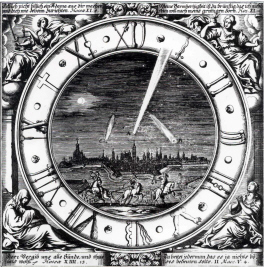 |
|
Woodcut showing destructive
influence of a fourth century comet from Stanilaus
Lubienietski's Theatrum Cometicum (Amsterdam, 1668). Image
credit: NASA/JPL |
The
illustration shows a view of Augsburg, Germany with the comets
of 1680, 1682, and 1683 in the sky. Image credit: NASA/JPL |
|
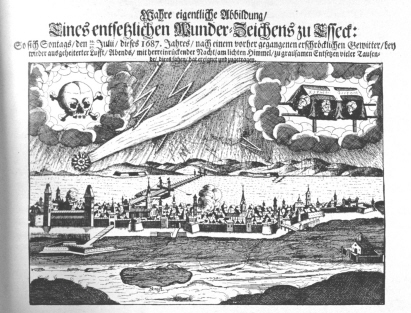 |
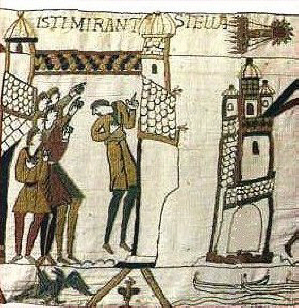 |
Image ID:
libr0021, Treasures of the NOAA Library Collection
Photographer: Archival Photograph by Mr. Sean Linehan, NOS,
NGS |
Tapestry
of Bayeux (Normandy) with Halley's comet. PD image. Source:
Wikimedia Commons/user Urban. |
The image below shows the portrayal of
the comet as bringer of sickness and even deformity in the Lucerne
chronicle.
.
|
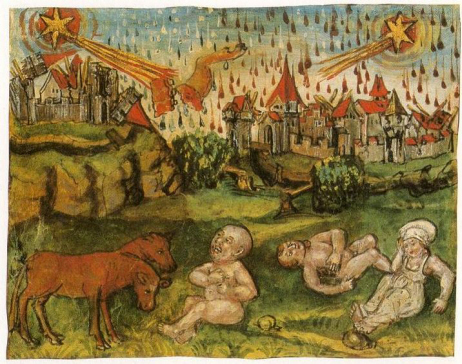 |
|
Luzerner Schilling 61v. 1513 AD. Source Wikimedia Commons. PD
image. |
Image of a comet from 1521 AD:
http://www.sott.net/image/image/5785/clube_comets.jpg
Nowhere was this
burden of the skies greater than in China where the Emperor was charged with maintaining the
stability of heaven, any change was seen as certain disaster and none more
so than a star that appeared where it should not, portending doom to the
nation. The significance of SN 1054 as an omen for the Emperor was so great that
it may have been hidden from him until later or ordered by him to be left off
the records. The Song dynasty does not have contemporary records of any
appearance of SN 1054 earlier than July 4th, but the Liao dynasty records
this star in connection with the eclipse of May and it is later recorded
in the “Sung-shih hsin-pien”, a 15th century manuscript. The interpretation of astronomical
events such as eclipses and comets could be used to oust an unpopular emperor and the fact that bad news of
this type appears to have been covered up leads one to think that either the
astronomers feared Renzong too much to deliver such a bad omen, or else this
Emperor enjoyed great support and had something worthwhile to offer the nation
(or at least the government officials). At the time of Tycho and even Kepler the heavens in Europe were still considered
immutable, it was in many places heresy to claim or even worse try to prove otherwise.
Some
astronomers were imprisoned by church authorities for such words, and some even put to death
for example for suggesting an heliocentric universe. On both
sides of the world and in both eras, the heavens were required to be
unchangeable and nothing could put the cat among the pigeons more than the
creation of a new star in the heavenly sphere of unchangeable stars. Celestial bodies as omens,
epidemics and misfortune from the stars, the official requirement for an
immutable heaven, a time of renaissance in art, technology, philosophy and
medicine, unite 11th century China and 16th/17th century Europe. It is in this backdrop of the
celestial bodies and disease that I turn to to attempt to connect the seemingly
unconnected contents of the botanical and non-botanical sections of the Voynich
Manuscript under this canopy.
Astronomy and medicine in particular were
long related in the form of medical astrology, plants, herbs and body parts
coming under the influence of zodiac signs and their ruling planets. Medicines
were
being prescribed according to which planet ruled the part of the body affected
and herbs gathered at certain times of the month or year when these influences
were strongest. This subject matter seemingly diverts one off into the realm of
superstition and quackery, but astrology and astronomy were once the same subject
and only later did they separate into separate disciplines. Astronomers of Tycho’s era and the Song dynasty were rarely purely astronomers,
it was part of the pursuit to understand the universe and other subjects were
also studied, often alongside medicine and astrology (medicine though was a
recent pastime of the educated elite in China). Tycho himself pursued many subjects
apart from
astronomy, including medicine, although he is most famous for his astronomical
successes, as a physician he was not so successful (which leads to the
conclusion that the later "botanical" sections if herbal do not relate to him on
any scale) but still it was an area he
dedicated himself to, and his sister Sophie even more so. Emperor Renzong
was personally interested in acupuncture and chemical medicine but was one of the main reformers
of Chinese medicine through necessity. He was a most unfortunate Emperor, many epidemics occurred during his reign, far more than for any other
emperor (10 occurring from 1045-1060 alone). He recognised the problems
the epidemics caused and early in his reign Renzong said that
there were no excellent physicians and that is why so many people were dying
before their time, this weighed heavily on him as a compassionate leader and he
determined the people should not be left to their fate.
Like the renaissance in Europe, the Song dynasty in China saw a huge
leap forward in technology (such as moveable print and gunpowder), understanding and thought and for the first time
nobles became seriously involved in the study of medicine, even emperors, which was thought
beneath them in former times. The rule of Renzong was more one of
pacification than war, scholarly learning (based mainly on Confucianism) and the governmental system became
more important than maintaining a large army, study was more and more open to those even from low station who
passed the official exams and became scholar-officials. Medicine became a matter of
scholarly interest and governmental obligation and classical texts lost to the past
were brought into the hands of physicians, whereas previously medicine had been
passed down through families or from master to disciple. Like Tycho, some were true
Renaissance men, Shen Gua
for example was an astronomer, mathematician, naturalist and medic and the
famous astronomers Su Song and Shen Kuo were experts in many fields. In some
areas China was way ahead of Europe in medicine, the ability to vaccinate against smallpox
had been practiced since the 10th century using infected material placed into
the nasal cavity and unlike Europe the use of metals and minerals was also
employed much sooner in medicine both by alchemists and physicians, along with
acupuncture, though issues of toxicity led to plant based medicines gaining
ground. Under Renzong a government sponsored revision of older pharmacopeia took
place, gathering and reinterpreting the information to be most effective in an
effort to ease the burden of the epidemics on the population. Renzong was
proficient in acupuncture and drug therapy and even
oversaw the production of some medicines donating valuable objects such as
precious Rhinoceros horn for
their use, believing the population should not be left to suffer. Cold damage disorders
(illnesses that had a sudden onset with fever and were often fatal), became a prominent feature of the literature and encompassed many of the
types of illnesses classed as plagues and epidemics.
In a previous attempt at translation I suggested that the female
figure on f66r was the "wife of an Emperor" (one of many wives) and that it recorded a death (of
the
infant and/or wife), although this was only one possible interpretation it fits
very well into my hypothesis. This folio occurs (in present
foliation order) after f57v which I suggested shows the eclipse of 1054 AD in
central China and a sighting of SN 1054, and before the general astronomical
section (f67r onwards) and the zodiac folios. f66r is in the midst of
botanical folios, including f65r which in an attempted translation in 2008 I
suggested was labelled, "comes forth bitterness" (produces soda (alkali)) and
referred to Wormwood (leaves), possibly shown as a plant amalgamated with wild
Quinine flowers or other plants. The "text" on f65r is unique on the
botanical pages being extremely short and may have a different purpose to the
other botanical folios, metaphorically, descriptions of bitterness, e.g.,
"Wormwood" are found to be associated with celestial bodies that bring
destruction and suffering.
|
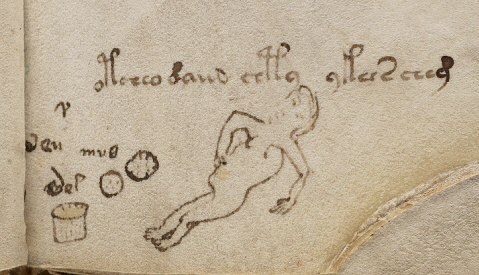 |
| Woman. f66r, cropped. Voynich Manuscript. Credit: Beinecke
Rare Book and Manuscript Library, Yale University. |
This raises a question though, if this is a noble Chinese woman, why are her feet
not shown covered or bound? The origins of foot binding have a
number of legends but non substantiated, the oldest actual recorded findings of
lotus shoes are in a tomb from 1243. Su Shih (1036-1101) of the
Song dynasty wrote a song of a dancer wanting to try foot binding. This may be
the real truth of the origin of foot binding that it was originally used to
temporarily hold the foot upright and in the shape of a crescent Moon much
like the modern ballet shoes, and its progress to the well known extreme form
was a result of social and gender pressures that came about in the
Song dynasty for women. In the early 12th century the scholar Chang
Pang-Chi claims they were a recent phenomenon and The Yuan dynasty writer T'ao Tsung-i (1366 AD) states that the practice was not generally observed
before the reign of Song emperor Shenzong, 1068-1085 AD. By the end of
the Song dynasty foot binding was the norm and lasted until the Manchurian
Qing dynasty when it was attempted to outlaw it, abhorring any trace of traditional Chinese
culture, but this did not last long and foot binding lasted into modern
times. Many palace portraits of empresses do not show the feet but in
the Song dynasty those that do up to 1194 at least show the empresses
sporting curled toe shoes that hook the long skirts rather than the tiny
straight lotus shoe of the bound foot. If this is indeed an early Song
dynasty noble lady then she may not yet have been exposed to foot
binding. Coincidentally, the end of the Ming dynasty and the
establishment of the Manchurian Qing dynasty coincided with the time Adam Schall von Bell introduced the work of Tycho (Di-gu) to China in a treatise
on Western astronomy written in Chinese and Jesuits are given an official
role at court. Early Jesuits such as Ricci (Ming dynasty) though did
not object to the practice of foot binding, but during the time of the Qing
dynasty when foot binding was not supported by the palace it is unlikely
that Jesuits in China would have supported it still. If the Voynich
Manuscript was written during the time of the Qing dynasty, with reference
to manuscripts from or about the pre-foot binding Song dynasty, then the
woman on f66r I describe as a wife of the emperor, being shown without bound
feet is appropriate to the practice of these eras "compared to any other
eras since the Tang dynasty up to modern times". Alternatively of
course, the author may not have known about the practice or the presence of
cultural clothing or adornment would too easily give away what was meant to
remain hidden.
This folio also displays Chinese writing
style characteristics in that there is an obvious vertical line of words and one
of glyphs on the left hand side of the folio.
|
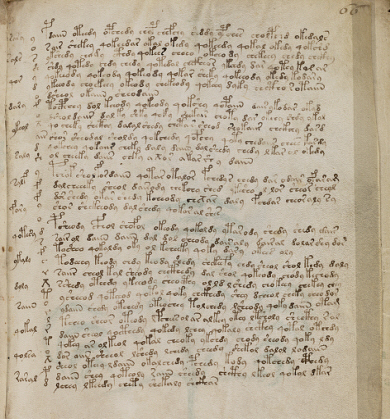 |
| Vertical writing. f66r, cropped. Voynich Manuscript. Credit: Beinecke
Rare Book and Manuscript Library, Yale University. |
Emperor Renzong, as mentioned above,
presided over one of the most unfortunate reigns in terms of the threat of
sickness to the nation and much of the progress made in his reign was with the
objective of solving, managing and treating better the many epidemics. He had 17 wives (Empresses
and consorts with high ranking titles) and many palace women (from 1056-1063
there were more than 10,000 palace women of all ranks), although an Emperor could
only have one official wife (the Empress) it was common for women to die in
childbirth and this partly accounted for the many wives and concubines taken
over the lifetime of an Emperor in a bid to produce a surviving male heir.
The Emperor himself is recorded to have lost a number of infants, 3 of his 16
children were boys who died in infancy leaving him with no blood heir, also some
of
the 13 girls died (the concubine Zhang (2) bore at least three children, all
girls who died in childhood).
His
official wife was the Empress Gao, she was chosen for Renzong by the Empress Dowager Liu when he ascended
the throne as a minor. He however was enamoured with another, Zhang (1) (whom he
named "Beautiful one" after her death and later bestowed her the title of empress) and the Empress was not only unloved but proved to be barren, so when
the Empress dowager Liu died he took the opportunity of her fight with two of
his favourite consorts to have her deposed - although she had stuck him such a
move was unprecedented. The other consort who fought with Empress Liu was
Yang-Shih (2) being a favourite she was also posthumously given the title
"empress" and such honour was sometimes a matter of the heart and
favouritism. Palace women were often promoted to imperial Consorts after giving
birth to children, Yu-Shih was one promoted after producing a girl and a boy,
other women were promoted through worthy service or family connection, being
mother of the regent or again just favouritism, and in the same way to offend the
emperor could lead to demotion of position or worse. Thus the roles and status of
the Palace women was complex and one stands out among all of the consorts of Renzong,
this was Zhang (2) she entered the palace as a minor and became the enduring
love of his life, he gave her the title "Precious Consort" in a ceremony (reportedly because she had saved him from a plot against
his life and later with the title "Noble Consort"). Ceremonies
however were normally
reserved only for empresses, concubines were a cross between wife and maid and
acquired or they acted as servants to the Empress and bore children for the
Emperor who they addressed as "master". Secondary consorts (just below the
empress) were not however of low status and were often women of high rank and
noble family background. The Emperor showered gifts and favours on
Zhang (2)
and her family openly and much to the distress of his advisors. After her
death Zhang (2) was given the title of "empress" also but from his behaviour
towards her and favouritism bestowed on her wider family it is clear that she
held a special place in his affection above all others. Zhang (2) died in 1054 or 1055 and what is interesting
is that her death coincided with the
appearance of the new star.
I suggest that the
woman on the bottom of f66r is most likely to be Zhang (2) and shows the
death of this important woman, and possibly her infant also. Her death not only coincided with
the appearance of the star but also may have been due to one of the many
epidemics that plagued his reign. The epidemics may have been considered to
have been exacerbated by the presence of the "guest star", and not even
the Emperor and his palace escaped their effects. Epidemics certainly occurred more than once in 1054 AD
and the epidemic
which occurred in Kaifeng was described as "大疫" which means "great plague", SN
1054 and the eclipse must have been seen as a curse by the Emperor. In
conclusion, I suggest that the contents of the first part of the manuscript may
consist of the star's appearance at the eclipse (which meant death to the
Emperor or at least danger to him and loss of heavenly support), the death of
his most beloved concubine (and possibly infant), the passage of the star over its life and a pharmacopeia of
remedies that could be used on the epidemics (that had long been around but the
evil star may have been blamed for any increase in number or severity of
epidemics). Interestingly, the Liao dynasty of
Mongolia squarely blamed the star for the death of their Emperor, Hsing Tsung. Records of SN 1054 exist from the Song and
Liao dynasties and although its presence before July may only have been noticed by the
Liao, although this seems unlikely. Another point of interest is that the 至和
(Zhihe era,1054 - 1056) of Renzong's reign covered the life of SN 1054 and
speaks of unsettled times, the next era 嘉祐 (Jaiyou era,1056-1063) may have
marked the disappearance of the threat from SN 1054 and speaks of excellent
protection. Although it was not the end of the epidemics and in 1058 there
is a record of a memorial made at court by top officials, that heaven blesses
the people by stopping the plague.
Epidemics were also common
place in Europe, and from the 14th
to 17th centuries there was plague somewhere in Europe almost every year without
exception. Tycho is noted to have avoided a visit to Wittenberg because of
plague in 1566, he left Copenhagen in 1592 because of plague which even reached
his island of Ven and in 1597 he left Rostock for the same reason.
Czech countries suffered three main plague epidemics between 1597 and 1680
(1597, 1613 and 1680), the plague of 1597-1599 was the culmination of many
localised outbreaks over the 16th century and was referred to as the "great
plague". In 1599 this epidemic along with dysentery forced Rudolph II himself to
abandon Prague temporarily and advise Tycho to avoid Prague, Tycho was charged
with supplying the Holy Roman Emperor with a secret elixir.
"In the official Danish Pharmacoposa
of 1658 several of Tycho's elixirs are given, and in 1599 he
provided the Emperor Rudolph with one against epidemic
diseases, of which the principal ingredient was theriaca
Andromachi, or Venice treacle, mixed with spirits of wine,
and submitted to a variety of chemical operations and ad-
mixtures with sulphur, aloes, myrrh, saffron, &c. This
medicine he considered more valuable than gold, and if the
Emperor should wish to improve it still more, he might add
a single scruple of either tincture of coral or of sapphire, of
garnet, or of dissolved pearls, or of liquid gold if free from
corrosive matter. If combined with antimony, this elixir
would cure all diseases which can be cured by perspiration,
and which form a third part of those which aflict the human
body. This prescription Tycho begged the Emperor to
keep as a great secret,"
from Tycho Brahe; a
picture of scientific life and work in the sixteenth century (1890)- Dreyer, J.
L. E. (John Louis Emil), 1852-1926
Prague was decimated by these plagues,
30,000 died in the 1597 plague, 1613-1614 and in 1680 83,000 were said to
have died in Prague, and so Kepler was also no stranger to these epidemics
either. In 1602, in his book "Concerning The More Certain Fundamentals of
Astrology" Kepler attributed illnesses including plague to unsettled weather,
conjunctions, eclipses and configurations of the Moon, Sun and the five planets.
He also ascribed events, generally of misfortune, war and even earthquakes to
certain conjunctions, for example, Saturn and Mars conjuncting in Scorpio
he ascribed to the St. Bartholomew massacre. He also talks about the
observation that the waxing and waning of the Moon affects moisture in
biological systems. Kepler suffered directly from these many epidemics losing his wife to an
infectious fever having previously survived Hungarian fever, epilepsy and
phrenitis. His children contracted smallpox and one died as a result.
Although mostly considered to be the realm of
superstition there are from time to time modern day studies into the effects of
the Moon on biological systems, epileptic seizures, bleeding ulcers, post
operative bleeding and the intensification of psychiatric disorders in relation
to lunar phase, with variable outcomes. The Moon influences the
tides and given natural light conditions the female fertility cycle runs closest
to its orbit, and it has been tentatively linked to post operative bleeding.
Some countries time the tree harvest to the new moon as the full and waxing moon
causes sap to rise and attracts pests that destroy crops. As recently as
2001 an article was published suggesting vets had noticed that illnesses
increased during the full Moon. Other modern day studies into the
effect of celestial bodies on biological systems include studies into the
correlation of peak Sun activity and the inferior conjunctions of Venus on
epidemics and some links on this subject area are given at the end of the page.
The understanding of celestial bodies
not only scientifically but in relation to the state of the nation, important
persons, general calamities and diseases (their
origin, course and how to treat them) was important to Tycho, Kepler and Emperor Renzong.
The emperor no doubt also suffered personal loss like Tycho and Kepler as a result of epidemics
and turned to his astronomers for meaning and advice.
LINKS
Emperor Renzong:
http://en.wikipedia.org/wiki/Emperor_Renzong_of_Song
http://history.cultural-china.com/en/46History2315.html
The rise and regency of empress liu
(969–1033) by John Chaffee, Binghamton university.
http://www.humanities.uci.edu/eastasian/SungYuan/JSYS/Archive/31/JSYS31_Chaffee.pdf
Women and the family in Chinese history by Patricia Buckley Ebrey.
http://books.google.co.uk/books?id=50BVVSU3mikC&lpg=PP6&pg=PP6#v=onepage&q=&f=false
SN
1054:
V. F. Polcaro and A. Martocchia (2005). Supernovae astrophysics from Middle Age
documents.
Proceedings of the International Astronomical Union, 1 , pp 264-268
doi:10.1017/S1743921306008416.
http://journals.cambridge.org/action/displayAbstract?aid=435825
Medicine in the Song Dynasty:
The Evolution of Chinese Medicine: Northern Song Dynasty,
960-1127 By Asaf Moshe Goldschmidt.
http://books.google.co.uk/books?id=-6_V8Q4ILO8C&lpg=PP1&ots=U1f9T-vjrj&dq=renzong%20song%20epidemic&pg=PR8#v=onepage&q=&f=false
The Song Dynasty:
http://en.wikipedia.org/wiki/List_of_Song_Emperors
http://www.chinaknowledge.de/History/Song/song-event.html
http://www.chinesechinese.net/HistoryofChina.html
http://en.wikipedia.org/wiki/History_of_the_Song_Dynasty
http://en.wikipedia.org/wiki/Culture_of_the_Song_Dynasty
http://en.wikipedia.org/wiki/Economy_of_the_Song_Dynasty
http://en.wikipedia.org/wiki/Society_of_the_Song_Dynasty
http://en.wikipedia.org/wiki/Technology_of_the_Song_Dynasty
http://www.china.org.cn/english/features/atam/115232.htm
Images of life in Kaifeng, capital of the
Northern Song Dynasty:
http://www.absolutechinatours.com/china-travel/Kaifeng/travel-guide.html
The celestial bodies and calamity:
http://www.scribd.com/doc/4641788/Johannes-Kepler-Concerning-The-More-Certain-Fundamentals-of-Astrology-1602
http://www.datasync.com/~rsf1/vel/iamds.htm
http://www.datasync.com/~rsf1/vel/1918ss.htm
http://news.nationalgeographic.com/news/2007/09/070921-meteor-peru.html
Yeung, J. W. K. (2006)
A hypothesis: sunspot cycles may detect pandemic influenza A in 1700-2000 AD.
- No link
On those heavenly pathogens:
http://66.102.9.132/search?q=cache:C8X6QMYArrYJ:www.ias.ac.in/currsci/aug102000/cr710.pdf+www.ias.ac.in/currsci/aug102000/cr710.pdf&hl=en&gl=uk
f65r plant:
f65r:
http://beinecke.library.yale.edu/dl_crosscollex/brbldl/oneITEM.asp?pid=2002046&iid=1006190&srchtype=ITEM
Wormwood:
http://www.purplesage.org.uk/images/photos/Wormwood
Koehler-Schoepke.jpg
Wild Quinine:
http://www.uis.edu/ppo/uisprairieproject/images/quinine2.jpg
Priclky Saltwort
http://www.cmog.org/usr/images/exhib/botanicalwonders/salsola_61_lg.jpg

Copyright © 2010 P. Han







